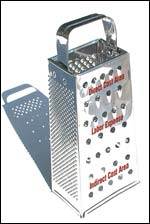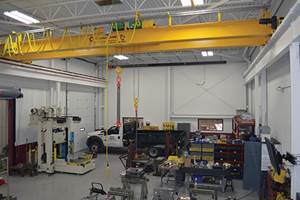Leadtime Leader Q&A: Conducting Leadtime Cost Analysis
Moldmaking Technology's 2003 Leadtime Leaders share their views on leadtime cost analysis and the role it plays in their shops.
The six winners of MoldMaking Technology magazine's First Annual Leadtime Leader Award Competition gather in this regular column to share some of their expertise about industry hot topics. The award-designed to recognize outstanding U.S. moldmaking shops and their ability to succeed in today's global mold market-recognized six shops that showed outstanding performance in the following areas: leadtime, current and projected sales growth, innovation in the moldmaking process as well as innovation in the business side of moldmaking, technology, industry involvement and customer service.
This time around, the Leadtime Leader experts weigh in on leadtime cost analysis and explain why it works-or doesn't work-in their shop. The following factors played a role in their discussion: measuring the cost-effectiveness of going withEa shorter leadtime with a higher price versus longer leadtime with a lower price, costs involved in shortening leadtimes (technology used, outsourced services, overseas costs, etc.) and are they worth it to the customer?
Steve Johanns, managing director, business development, Advance Tool, Inc. (Blaine, MN)
Leadtimes have always been a major driver with ATi customers. We are continually searching for ways to reduce our leadtimes without sacrificing quality. Great people, ideas, technology and an attitude of 'Get Better or Die' are what help us keep driving leadtimes down. On average, our leadtimes are 20 to 25 percent better than the industry as a whole. To get an idea on how that translates into opportunity, we recently built a mold using 9,000 man-hours in ten weeks. Our success allowed the customer to get their new product to a major tradeshow ahead of a competitor and begin taking orders. How much do you think that is worth? Where do you think they will go for their next mold? How do you think they perceive ATi's value? Different customers perceive quality and service differently-but time and money are quantifiable numbers. Companies that are focused on leadtimes and service in any industry have a higher perceived value by the customer, and it is that higher perceived value that ends up on the bottom line.
Jason Jepsen, Tech Centre manager, Eimo Americas (Vicksburg, MI)
For us, shortened leadtimes don't necessarily equate to higher tooling prices. Our customers have come to expect very high tooling quality coupled with shortened leadtimes at a competitive price. This is a challenging balancing act that we must continuously review and try to improve upon. Our main mode of keeping these three aspects in check has been through continued focus and gradual implementation of lean manufacturing.
Two of the key principles of adopting new lean techniques are: improving efficiencies and reducing errors. There are many obvious benefits to both of these aspects. When we originally started investigating lean and its potential benefits, our focus was exclusively on the reduction of leadtimes. As we move forward with lean we're finding that a very desirable by-product is the reduction of our internal costs. Most of this is attributed to fewer errors due to some of the systems we have put in place. It sounds strange to say "reduced leadtime" and "reduced cost" in the same sentence, but it's something we look forward to exploiting and expanding upon in the future.
We do contract some facets of the tool build with outside services to help reduce leadtimes. This is something we've done for many years. We simply recognize that there are companies that specialize in specific mold components that can produce them much more efficiently than we can. We would rather use their expertise and consider many of these components to be standard. Again, we don't view this as something that would lead to a higher tooling price since the efficiencies should already lie with the outside service provider.
Rich Burman, president, Graphic Tool Corp. (Itasca, IL)
First of all, our normal deliveries are 40 to 50 percent shorter than they were five years ago. This is due to changes we have made in the way we manufacture molds. The technology available today-computer software, high-speed machining and our internal process-have allowed us to reduce our normal deliveries to what they are today. If a shorter delivery is required, we can accommodate this by adding more overtime to the job. We also might outsource things we would normally do in-house. This could add 15 to 30 percent to the cost of the job. It is up to the customer-based on his need for the product-to decide if it is worth it.
Mike Richard, president, M&M Tool & Mold, Inc. (Green Bay, WI)
We have not been in a position to conduct a leadtime cost analysis. That has been our customers' decision once we present them with both scenarios. There is kind of an industry standard out there of four to seven weeks on production molds-therefore, you find a way to do it and make a profit. Some of the costs we encounter expediting delivery are shipping charges, overtime and outsource premiums. With a smaller shop like ours, we also have to watch employee burnout. A week ago, I was asked to give an improved delivery price to three different customers on three different projects. With that said, I would have to say they are worth it to our customers.
Brian Evans, CAD/CAM designer, Peterboro Tool Co., Inc. (W. Peterborough, NH)
For us, a leadtime cost analysis depends on our current workload and/or the customer's leadtime. If our current workload is slow, we may quote a lower price and quicker turnaround due to the fact that we may have more manpower for the job. Also, we hope that these factors will land us the job. If we are very busy and the customer comes to us with a hot job, we usually have to quote a higher price and longer leadtime if there aren't people to get the job started immediately. Sometimes the customer's leadtime is more of an issue than price; therefore, more money can be had on a job if landing it doesn't jeopardize the current workload.
We like to keep most of our work in-house where we have more control of it. If we are in need of a certain technology that we don't currently posses, then , of course, we must outsource it, preferably to a local vendor.
Wayne Shakal, business development manager, Ultra Tool Group (Grantsburg, WI)
A leadtime cost analysis can be performed using many different variables. There are three common methods. The first is to calculate the cost per day for a team of people that are assigned to a program. For example, an OEM or molder has ten people working on a program. If the average cost per person is $50/hour x 40 hours x 10 people the weekly cost is $20,000. In other words, by completing a program a week earlier and freeing these people to move on, it will save $20,000 on the program.
The second method is to calculate the loss in sales for every day the product is not on the market. To do this, multiplying the selling price by the volume that can be sold per day will determine the loss in sales due to not being in production. In addition, moldmakers may not know product end-selling price. With basic figures such as hourly injection molding machine rate, secondary operation requirements, material costs and estimated profit margin, a ballpark product price can be calculated. This only works if the molded product is not part of an assembly or is the major component of an assembly.
Finally, there is a fiscal impact of bringing a product to market before the competition does. Data has shown that the company that brings a product to market first usually experiences the most profitability on the sale of that product. Costs associated with expediting the mold build process mainly involves the additional job overtime to hit the delivery and the inefficiency of other projects in the queue caused by the disruption of expediting through another project.
Related Content
The Trifecta of Competitive Toolmaking
Process, technology and people form the foundations of the business philosophy in place at Eifel Mold & Engineering.
Read MoreThink Safety: Eliminate Hazards Throughout the Shop
The tooling community is taking advantage of new products for safer mold shops and molding facilities.
Read MoreDynamic Tool Corporation – Creating the Team to Move Moldmaking Into the Future
For 40+ years, Dynamic Tool Corp. has offered precision tooling, emphasizing education, mentoring and innovation. The company is committed to excellence, integrity, safety and customer service, as well as inspiring growth and quality in manufacturing.
Read MoreHow to Improve Your Current Efficiency Rate
An alternative approach to taking on more EDM-intensive work when technology and personnel investment is not an option.
Read MoreRead Next
A Cost Structure Cheese Grater for Businesses
A quick, simple and inexpensive method of computing the indirect costs for pricing, bidding and estimating for small shops.
Read MoreHow to Use Strategic Planning Tools, Data to Manage the Human Side of Business
Q&A with Marion Wells, MMT EAB member and founder of Human Asset Management.
Read MoreHow to Use Continuing Education to Remain Competitive in Moldmaking
Continued training helps moldmakers make tooling decisions and properly use the latest cutting tool to efficiently machine high-quality molds.
Read More



















